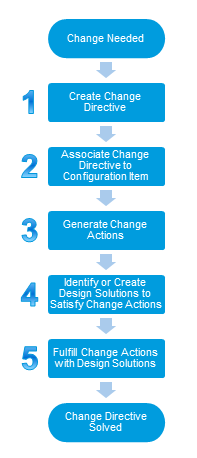About Configuration Level Change Management
Windchill includes standard change management functionality that is used to manage change at the upper level and lower level of the product structure. Windchill Aerospace & Defense Configuration Items and Design Solutions configuration management includes specialized functionality to handle the needs of the change process at the configuration level.
|
|
The standard Windchill change management process is used in the upper and lower levels of the product structure. For more information, see About Change Management. |
Windchill Aerospace & Defense Configuration Items and Design Solutions configuration level change management includes the following change objects:
• Change Directive—A change to the configuration level of the product structure.
• Change Action—A statement of work required to implement a change directive. The definition of a missing solution needed to fulfill a change.
Change Process
The Windchill Aerospace & Defense configuration level change management process uses the following workflow:
1. The user creates a new change directive, providing a description of the change being requested and the effectivity range for which the change applies.
2. The user determines the set of affected configuration items that are impacted by the change and associates them with the new change directive.
3. The user selects the Generate Change Actions action.
One or more new change actions are generated with the To be studied status. Each new change action prompts the following actions:
◦ The system examines any existing change actions for the affected configuration item and determines the new set of change actions that are needed to implement the change.
◦ The system creates the new change actions that are needed for the change directive and calculates the effectivity ranges for which they apply.
◦ The system informs the user if there are current design solutions that are under investigation as a result of implementing the pending change. For example, if a design solution has already been used to solve a change action for a given configuration item and applies to an effectivity range of 001-500, and a new change action for the configuration item applies to an effectivity range of 400-500. The design solution is marked as
Under Investigation and the configuration item
Effectivity Warning column lists a warning for the effectivity range of 400-500, because it might no longer be applicable and a new design solution would be required to fulfill the new change action. For more information, see
Change Examples .
4. The user investigates each of the new change actions and determines whether existing design solutions satisfy the change actions or if new design solutions need to be developed.
| Design solutions must be associated with a configuration item. You can associate existing design solutions or create new design solutions from the information page of the configuration item. For more information, see Managing the Product Structure . |
5. The user completes the Fulfill Change Action action for the affected configuration item and selects the appropriate design solution.
The Fulfill Change Action action prompts the following changes:
◦ The system sets the effectivity for the specified design solution. This effectivity range is set based on the effectivity range specified in the change action.
◦ The system adjusts the effectivity ranges of pre-existing design solutions associated with the configuration item, if necessary.
For example, if an existing design solution is associated with a configuration item for an effectivity range of 001-500, but a change action requires a new design solution for that configuration item for an effectivity range of 400-500. A new design solution fulfills the change action for a range of 400-500, and the design solution that existed prior to the change is modified to apply for an effectivity range of 001-399.
| A design solution that fulfills a change action cannot be removed or deleted unless the user performs the Undo Fulfill Change Action action. For more information, see the Scenario 2 from section Change Example 2 in the Change Examples topic. |
Related Topics
